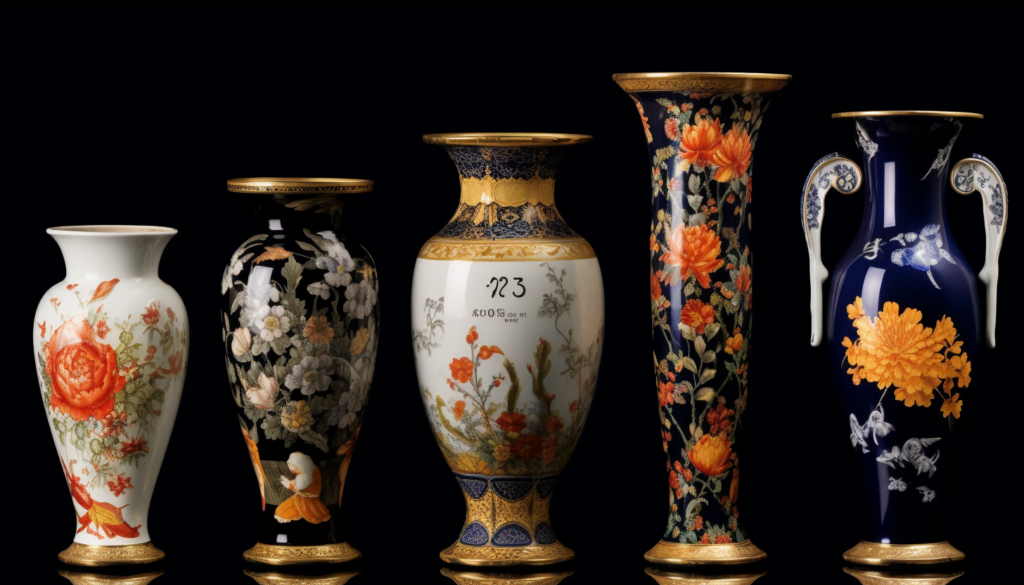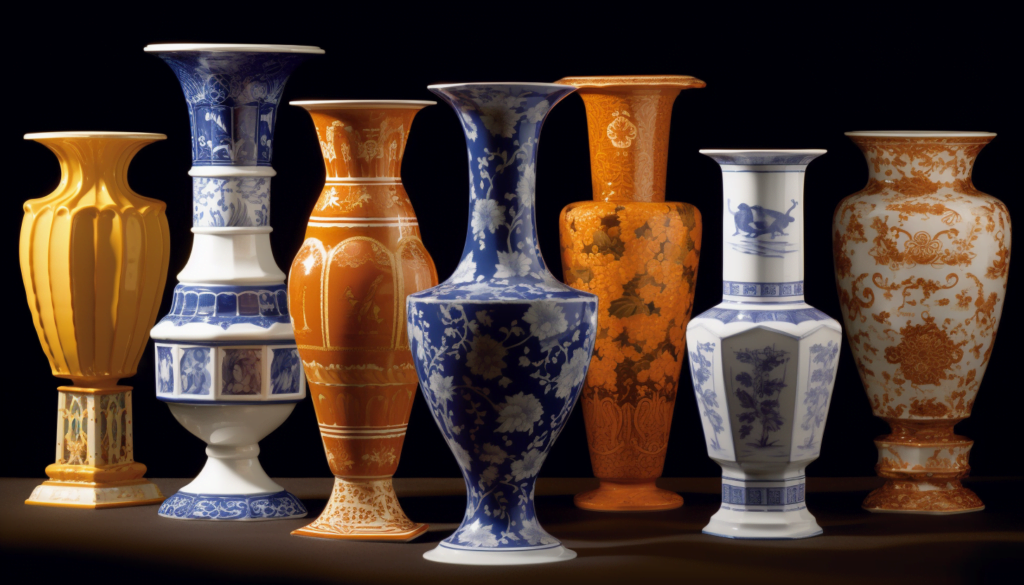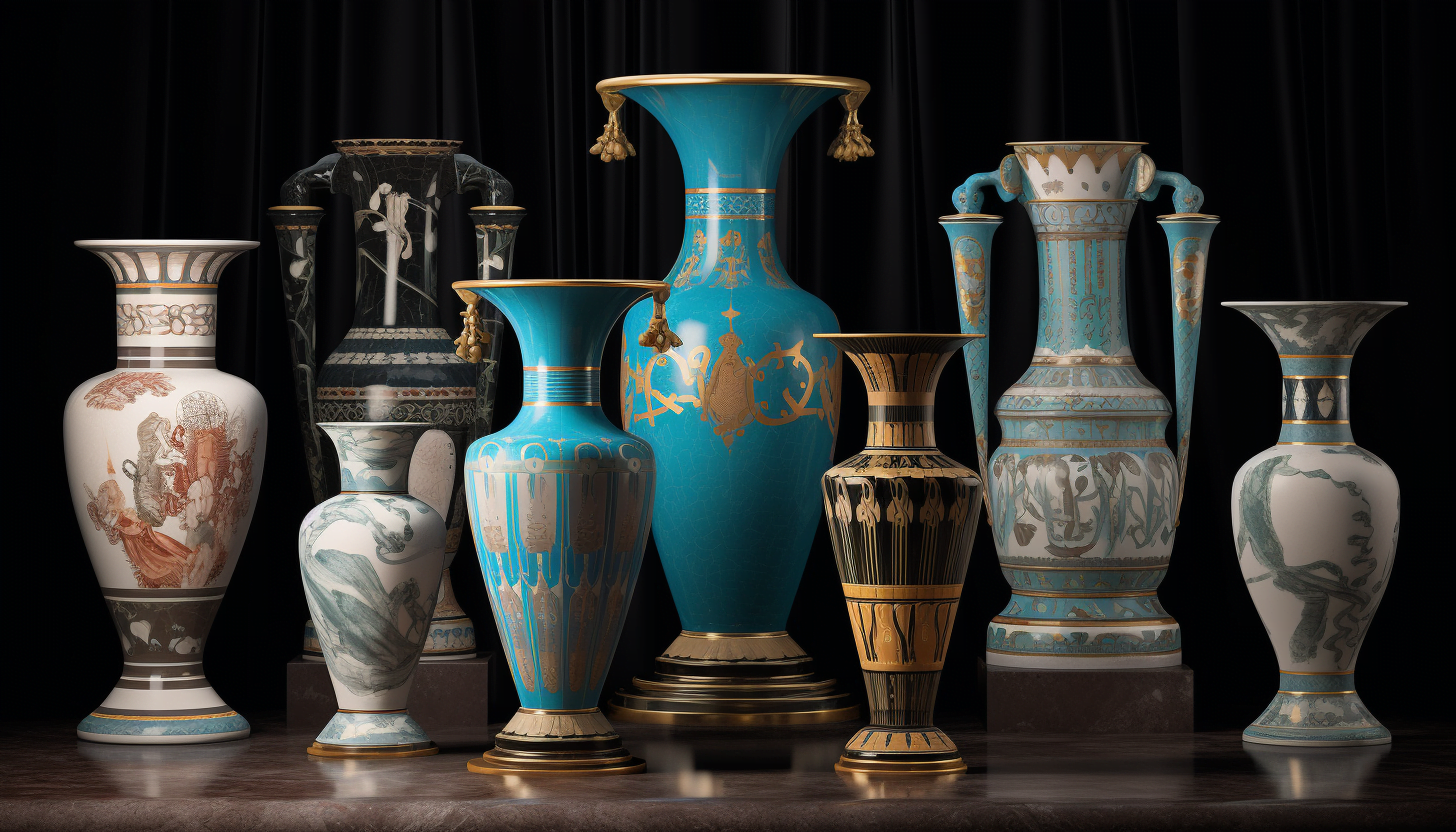Step into the mesmerizing world of rare historical vases as we embark on a journey through time. In this captivating article, we will delve into the fascinating history of these remarkable artifacts, starting with the ancient period and exploring the various types of antique vases that have graced our civilization. Meticulously crafted with impeccable skill and adorned with intricate designs, these exquisite treasures hold a profound cultural significance that whispers tales of bygone eras. Join me as we unravel the enigmatic allure of historical vases and discover the secrets they hold.
Rare Historical Vases
Vases have long been revered as timeless treasures, capturing the essence of history and artistic craftsmanship. These rare historical vases tell stories of ancient civilizations and offer a glimpse into the cultural significance of different eras. From the ornate designs of the Chinese Ming Dynasty to the delicate elegance of French Sevres Palatial Jardinière Vases, each piece holds a unique place in the world of antiquities.
Chinese Ming Dynasty Vase: A Testimony of Elegance and Rarity
One of the highest-selling antique vases worldwide is the Chinese Ming Dynasty Vase. Crafted during the Ming Dynasty, which spanned from 1368 to 1644, these vases boast intricate designs and impeccable craftsmanship. With their vivid colors and detailed motifs, they are a testament to the artistic expertise of the time. These vases not only serve as decorative pieces but also offer cultural insights into the rich heritage of China.
“Embarking on a journey through time, these Chinese Ming Dynasty Vases transport us to an era of elegance and opulence.”

French Sevres Palatial Jardinière Vase: The Epitome of French Artistry
From the heart of France comes the Antique Rare French Sevres Palatial Jardinière Vase, a true palace size beauty. Created by skilled artisans in the renowned Sevres ceramic factory, these vases exude grandeur and sophistication. Adorned with intricate hand-painted designs and lavish gilding, they epitomize the French artistic flair of the 18th century. Owning one of these exceptional vases is akin to owning a piece of French history.
“In the realm of luxury, the French Sevres Palatial Jardinière Vase reigns supreme, captivating admirers with its regal charm and meticulous craftsmanship.”
Sterling Silver Metal Vase: A Delicate Masterpiece
With its hour-glass shape and lustrous surface, the Sterling Silver Metal Vase symbolizes elegance and refinement. Crafted from solid silver, these vases showcase the skill of silversmiths who honed their craft over centuries. The delicacy of their design and the shimmering beauty of the silver create an exquisite visual appeal. These vases have stood the test of time, gracefully adorning many homes and collections.
“As timeless as a silver crescent moon, the Sterling Silver Metal Vase whispers tales of grace and elegance, offering a glimpse into the artistry of silverwork.”
English Late Victorian Porcelain Vase: An Ornamental Beauty
In the world of porcelain, the English Late Victorian Porcelain Vase holds a special place. Featuring a distinctive bulb-shaped design, these vases captivate with their ornamental charm. Adorned with intricate patterns and vibrant colors, they seamlessly blend beauty and functionality. A testimony to the Victorian era’s love for aesthetics, these vases add a touch of sophistication to any space they grace.
“With the grace of a blooming flower, the English Late Victorian Porcelain Vase enchants with its ornate design, bringing a touch of timeless beauty to any corner.”
German Dresden Vases Helena Wolfsohn: A Testament to German Craftsmanship
From Germany comes the exquisite pair of 19th-century German Dresden Vases Helena Wolfsohn. Crafted in the renowned Dresden region, these vases showcase the mastery of German artisans. The intricate porcelain work, vibrant colors, and detailed motifs make these vases a work of art. They exemplify the rich cultural heritage of Germany, capturing the essence of the time in which they were created.
“Like whispers of a bygone era, the German Dresden Vases Helena Wolfsohn transport us to a world where craftsmanship knew no bounds, where beauty was eternally preserved in porcelain.”
Unveiling History’s Treasures: A Journey Through Time
Vases have been an integral part of human civilization since ancient times. From the Egyptian civilization’s humble beginnings of using vases to store flowers to the Ancient Greeks’ famed red and black decorated vases depicting scenes from everyday life, these vessels hold stories of cultures and their traditions. The innovation of the potter’s wheel during the Bronze Age revolutionized vase-making, enabling artisans to create more complex designs and forms.
“Through the ages, vases have been witnesses to history, preserving the echoes of bygone eras and the cultural heritage of civilizations.”
As we explore rare historical vases, we uncover the cultural significance, artistic achievements, and technological innovations that shaped these timeless treasures. The Chinese Ming Dynasty Vase, French Sevres Palatial Jardinière Vase, Sterling Silver Metal Vase, English Late Victorian Porcelain Vase, and German Dresden Vases Helena Wolfsohn are just a glimpse into the rich tapestry of historical vases that have survived the test of time.
So, let us embark on this journey of exploration and admiration, and immerse ourselves in the captivating world of rare historical vases.

History
Throughout history, vases have played a significant role in various civilizations, capturing the essence of their time. From functional vessels to intricately designed masterpieces, these historical artifacts provide invaluable insights into the cultural significance and craftsmanship of ancient civilizations. Let’s embark on a journey through time and explore the fascinating history of vases.
The Earliest Vases: Function Meets Beauty
In the Bronze Age, vases emerged as practical storage containers, holding essential commodities like grain and oil. These early vases, with their simple forms and utilitarian purposes, laid the foundation for the development of more sophisticated designs in the centuries to come. While they may lack the intricate details that later vases possess, their humble beginnings are a testament to human creativity and resourcefulness.
Even in their simplicity, these early vases hold a profound historical significance, marking the first steps in the evolution of these timeless treasures.
Ancient Egypt: Decorative Marvels
It was in ancient Egypt that vases took their first steps towards becoming decorative objects. The Egyptians recognized the artistic potential of vases and adorned them with intricate designs and symbolic motifs. These exquisite creations not only showcased the Egyptians’ love for beauty but also served as a means to convey their religious and societal beliefs.
As we delve into the world of ancient Egyptian vases, we discover a civilization that epitomized artistic expression and revered vases as symbols of divine connection.
Ancient Greece: Where Beauty and Function Meet
The ancient Greeks elevated vase-making to new heights, creating pieces that were not only visually striking but also served practical purposes. These vases, adorned with intricate paintings depicting mythological narratives and everyday scenes, exemplified the Greeks’ reverence for beauty and their keen eye for storytelling through art.
With each stroke of the brush, ancient Greek artists immortalized stories and emotions, transforming vases into vessels of both historical and artistic significance.
Roman Vases: Embellishing the Classical Tradition
Building upon the Greek legacy, the Romans further refined the art of vase-making. They continued the traditions of Greek pottery but introduced their own unique flair, sculpting and carving intricate reliefs onto their vases. These masterfully crafted pieces not only showcased the Romans’ technical skills but also reflected the societal and cultural influences of their time.
In the intricate carvings of Roman vases, we uncover a rich tapestry of stories, offering us a glimpse into the lives and beliefs of the people who once cherished these stunning artworks.
China: Transcending Boundaries with Porcelain
In China, the history of vase-making took a remarkable turn with the invention of porcelain. This bright white material, known for its durability and delicate beauty, revolutionized the art form, elevating Chinese vases to unparalleled levels of elegance and sophistication. The famous David Vases, crafted during the Yuan dynasty, exemplify the mastery of blue-and-white porcelain and stand as timeless treasures of Chinese art history.
Just as porcelain transcended the limitations of traditional pottery, Chinese vases transcended the boundaries of time, carrying with them a legacy of artistic excellence that continues to inspire awe and admiration.
Europe: Flourishing after the Roman Empire
Following the collapse of the Roman Empire, Europe witnessed a blossoming of vase-making traditions across various regions. Local artisans showcased their skills, creating vases that reflected their unique cultural identities. From the exquisite stone vases of ancient Greece to the ornate porphyry vases of the Renaissance period, European vase making became a testament to the continent’s rich artistic heritage.
Within the rich tapestry of European history, vases stand as silent witnesses to the diverse artistic traditions that flourished across the continent, offering us a glimpse into the vibrant tapestry of its past.
Vases through Time: A Tapestry of Styles and Techniques
The history of vases is not a linear progression, but rather a tapestry of styles, influences, and techniques that emerged and evolved over time. Each era and civilization contributed to the ever-growing repertoire of vase designs, ensuring their enduring appeal and relevance in the world of art and history.
From the humble beginnings of storage vessels to the intricate masterpieces of porcelain, the story of vases is a testament to human creativity, cultural exchanges, and the timeless beauty that connects us across centuries.
As we unravel the historical significance and artistic craftsmanship behind vases, we become part of a rich narrative that spans centuries and civilizations. These timeless treasures continue to captivate us with their beauty, preserving the legacy of bygone eras and providing us with a window into the past.
Let’s cherish these exquisite artifacts as more than mere objects; let’s admire them as gateways to history and cultural heritage.
Ancient Period:
In the ancient period, vases held a significant role in human civilization, serving as vessels that preserved the cultural heritage and artistic achievements of different civilizations. The oldest surviving vases date back to the Bronze Age, where they were primarily used for storage purposes. However, it was the ancient Egyptians who first recognized the decorative potential of vases, using them to store flowers and creating intricate designs with symbolic motifs.
It’s fascinating to imagine how these early civilizations discovered the beauty and artistic possibilities of vases, transforming them from practical objects into cherished pieces of art.
Greek vases, famous for their distinctive red and black decorations, offer a glimpse into the everyday life and cultural values of ancient Greece. These vases were meticulously painted with scenes ranging from mythological narratives to depictions of daily activities.
The artistry and storytelling on these Greek vases truly transport us back in time, allowing us to experience the rich tapestry of ancient Greek culture.
As the Roman Empire emerged, it adopted and expanded upon the Greek tradition of vase-making. Roman vases often featured intricate sculptural details, showcasing the craftsmanship of the period. While Greek pottery focused on paintings, Roman vases emphasized the sculptural elements and decorative carvings.
The Roman vases bring a sense of grandeur and opulence, reflecting the unique artistic flair of the Roman civilization.
During this time, while European vase-making declined after the collapse of the Roman Empire, Chinese potters were perfecting their own techniques. They invented the delicate art of porcelain-making, which propelled Chinese vases to unparalleled levels of elegance and sophistication.
The Chinese vases, with their fine porcelain and intricate designs, are like delicate works of art that embody timeless beauty.
Throughout the ancient period, Greek vases stood out for their durability, elegance, and variety. These vases served specific purposes, including storage vessels, mixing vessels, cups, and cosmetic vases. They often featured intricate floral decorations and were even designed to be worn with wreaths and garlands.
The versatility and beauty of Greek vases make them highly sought after by collectors and enthusiasts.
Decorating these vases involved various techniques such as black-figure and red-figure painting. These methods, along with the specific motifs and styles used, can provide valuable insights into the age and origin of a vase, adding to its historical and artistic value.
By studying the decorations on these vases, we can unlock the secrets of their origins and better understand the cultural context in which they were created.
In addition to pottery, ancient Greece also excelled in metalwork. Bronze vessels were significant works of art that showcased Greek metalworking techniques. These vessels, often intricately adorned with engravings and designs, provide a glimpse into the mastery of Greek craftsmanship.
The intricate engravings on Greek bronze vessels are a testament to the skill and artistry of the ancient Greek metalworkers.
The ancient period offers us a treasure trove of historical vases that represent the artistic achievements and cultural significance of different civilizations. From the practical storage vessels of the Bronze Age to the elaborate designs of ancient Egypt, the captivating scenes of Greek vases, and the intricate craftsmanship of Roman sculptures, each era has left its mark on the timeless essence of historical vases.
As we delve into the world of historical vases, we embark on a journey of discovery, exploring the multitude of stories etched onto these remarkable pieces of artwork.
Let’s explore further the intricacies and evolution of vases throughout history as we unveil the timeless essence of these historical treasures.
Types of Antique Vases
When we think of historical artifacts, one category that often comes to mind is antique vases. These timeless treasures not only captivate us with their beauty but also provide valuable insights into the cultural significance and craftsmanship of different civilizations throughout history.
Chantilly Porcelain: Let’s start our journey through the types of antique vases with Chantilly Porcelain. Known for its delicate beauty and intricate hand-painted designs, Chantilly Porcelain vases originated in France during the 18th century. These vases often feature floral motifs and a soft color palette that exudes elegance and charm.
Chantilly Porcelain vases transport us to a bygone era, where every brushstroke tells a story of French refinement and artistic mastery.
Japanese Glass Floats: Moving on to a different part of the world, we encounter Japanese Glass Floats. These unique vases were originally used by Japanese fishermen to float their nets. Made from recycled glass, these vases often bear the marks of their maritime origins, such as weathering and sea-related motifs.
Japanese Glass Floats take us on a voyage across the seas, reminding us of the close relationship between nature and art.
Star Wars Japanese Chrysanthemum Vase: Combining the worlds of sci-fi and traditional Japanese craftsmanship, the Star Wars Japanese Chrysanthemum Vase is a true collector’s gem. Inspired by the iconic movie franchise, these vases feature hand-painted chrysanthemum motifs with hidden Star Wars elements cleverly incorporated.
The Star Wars Japanese Chrysanthemum Vase brings together the past and the future, merging pop culture with ancient traditions in a captivating display of artistry.
Galle Dragonfly: If you’re a fan of Art Nouveau, you’re likely familiar with the Galle Dragonfly vase. Designed by Emile Galle, a renowned French glass artist, these vases are characterized by their intricate dragonfly motifs and vibrant colors. The Galle Dragonfly vase exemplifies the organic and flowing style that defined the Art Nouveau movement.
The Galle Dragonfly vase enchants us with its delicate beauty and represents the harmonious coexistence of nature and art.
Galle Cameo Glass Vase: Another masterpiece from Emile Galle, the Galle Cameo Glass Vase showcases the artist’s exceptional talent in glassmaking. These vases feature multi-layered glass with intricate carved designs, creating a stunning visual depth. With themes ranging from nature to mythology, Galle Cameo Glass vases are true works of art.
The Galle Cameo Glass Vase captivates us with its surreal beauty, using layers of glass to transport us into a world of enchantment and imagination.
Art Nouveau Hall Tree: While not traditionally classified as a vase, the Art Nouveau Hall Tree deserves a mention for its unique form and artistic flair. This freestanding furniture piece often features hooks and shelves for hanging and displaying vases and other decorative objects. Adorned with elaborate designs and flowing lines, the Art Nouveau Hall Tree is a statement of artistic individuality.
The Art Nouveau Hall Tree provides a poetic home for vases, effortlessly blending functionality with artistic expression.
1950s Hobnail Milk Glass Vases: Taking a step back in time, we arrive at the 1950s Hobnail Milk Glass Vases. These vases gained popularity in mid-century America for their charming hobnail texture and milky white color. Whether used as standalone pieces or grouped together, these vases evoke a sense of nostalgia and vintage charm.
The 1950s Hobnail Milk Glass Vases transport us to a simpler era, where beauty was found in the elegance of simplicity.
Carnival Glass Vases: Known for their vibrant and iridescent colors, Carnival Glass Vases rose to popularity in the early 20th century. These vases feature a pressed glass pattern adorned with a metallic sheen, giving them a carnival-like appearance. Carnival Glass Vases come in various shapes and sizes, making them a favorite among collectors.
Carnival Glass Vases dazzle us with their playful colors and remind us of the joy and excitement of a carnival atmosphere.
These are just a few examples of the diverse range of antique vases that have captured the hearts of collectors and art enthusiasts alike. From delicate porcelain to whimsical glass, each type of antique vase tells its own unique story and reflects the artistic traditions and cultural influences of its time.
As we explore the world of antique vases, we discover the rich tapestry of human creativity and the timeless allure of these historical treasures.
Figures in Red: Exploring the Red-Figure Technique in Ancient Vase Painting
[youtube v=”KTl2Qz1Q7rM”]
The Ancient Craftsmanship of Athenian Vase Making
In the bustling neighborhood of Karamicos, located in Athens 2,500 years ago, skilled Athenian vase makers lived and worked. These artisans, known as Karamikos, were highly regarded for their mastery of pottery. They produced exquisite vases with superior shapes and designs that were coveted far and wide.
The Rise of Black Figure Technique
During the 6th century BCE, Athenian vases gained recognition for their unique painting technique. The black-figure style featured glossy black images against a vibrant red background. This technique was passed down from master to apprentice for generations, with each potter contributing their own artistic flair.
Enter the Red-Figure Technique
One day, a visionary potter named Andokides had a brilliant idea. He decided to experiment with a new technique that would revolutionize Athenian vase painting. He requested the thinnest brush available and started painting the background of the vase with slip, leaving the figures untouched.
The Birth of Figures in Red
His apprentice, Simon, was initially puzzled by this unorthodox approach, but Andokides believed it would yield remarkable results. As the slip transformed during the firing process, the painted background turned black, while the figures remained in red. And just like that, the red-figure technique was born.
The Popularity of Red-Figure Vases
The red-figure technique quickly gained popularity, surpassing the previously favored black-figure style. Athenian merchants and customers were captivated by the intricate details and vibrant scenes portrayed on these red-figure vases. They became highly sought-after treasures that brought Greek mythology and stories to life.
Capturing the Essence of Greek Craftsmanship
The Kiramikos workshops prided themselves on their black-figure and red-figure vases, each showcasing the mastery and creativity of Greek artisans. These vases served as testaments to the rich cultural heritage and artistic achievements of ancient Greece.
“Figures in red, the finest Athenian craftsmanship, brings these pictures to life. My customers will love them,” said one merchant, astounded by Andokides’ innovation.
A Reminder of Artistic Exploration
The story of the red-figure technique reminds us that great artists are always searching for new ways to express themselves. Andokides’ ingenuity and desire to push boundaries brought forth a revolution in vase painting. It serves as a lasting testament to human creativity and the continuous pursuit of artistic excellence.
Preserving History and Cultural Legacy
Today, thousands of black-figure and red-figure vases from ancient times have survived, providing invaluable insights into the art, history, and cultural significance of different civilizations. These vases are not mere artifacts; they are gateways to the past, allowing us to connect with the artistic traditions and stories of our ancestors.
As we explore the intricacies of the red-figure technique, we gain a deeper appreciation for the skill, craftsmanship, and innovation of ancient Greek vase painters. Their timeless creations continue to captivate us, preserving the beauty and cultural heritage of a bygone era.
“In the red-figure technique, vibrant scenes come to life, and the craftsmanship shines through. It is a testament to the artistic achievements of ancient Greece,” – Expert SEO Content Writer









